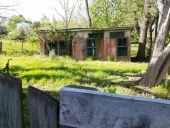Thanks for the ideas!
S Bengi - I don't quite understand what this means -
S Bengi wrote:Plant seeds and graft a named cultivar on top of it, that way your fruiting plants will not topple over easily.
- could you explain a little more? As for cabin plans, we're going with a pretty open plan with windows placed to take advantage of the different views, as well as some solar gain. Similar to the image you posted, but rearranged so that the living area is along one long side so views from three different directions can be enjoyed from kitchen/living/dining area (which will be pretty much the same thing) and the bedrooms and bathroom are along the back long wall. It's something we will enjoy, and have appeal for renters/buyers in the future if it goes that direction.
Bill Bradbury - Thanks! We're really excited to have this piece of property, and looking forward to what we can do with it as we go through this adventure. The Aspens are a bit away from the proposed home site, I just put that pic up to show off the view a little bit. The majority of the property looks more like the pics I'm attaching to this post. Looking around, all of the trees seem like thinner, more spindly versions of what I see at lower elevations around here. Would thinning the Aspens allow the remaining trees to get bigger?
Unfortunately, the way the codes are around here, I'm thinking we're just going stick built for this one. I know it will go a lot quicker and more smoothly with the county that way. We won't be able to do everything we want with growies and livestock anyway, so we're likely to make something nice and marketable and sell it for a tidy profit to fund a larger, more suitable place down the road. Or we could keep it for a nice vacation spot to use sometimes, rent sometimes. Leaving options open at this point. We are going try growing a bunch of different stuff to see what we can make work with the elevation, seasonal cold and lack of ability to water anything (indoor only household wells are all that can be permitted).
Miles Flansburg - Glad to be here! I've only walked the original 4.36 acres. We bought 3.06 acres which, when surveyed, turned out to be 4.36 acres (score!). I walked it a few times and started planning within its confines when the county offered to sell us two other adjacent parcels of former BLM land. One is supposed to be 5.66 acres and one is supposed to be .65 acres. We actually just got the paperwork signed and notarized today for the last parcel, so after the county does their magic we will have another survey done and I'll go check out what we have now.
The aspens definitely have more stuff growing under them and the soil seems a lot better there. That little acre or so of aspens is at the far south end of the property a decent ways from the home site. I'll definitely plant stuff down there, but it won't get daily attention so I'm hoping to focus any real effort close to the house, which looks more like the attached picture with the tent in it. Mostly rock covered with needles.
I haven't seen any water or places where water gathers and runs. I have a feeling everything just soaks down into cracks in the rock unless there's a ton of rain dumping. Of course, a good deal of our precipitation will be in the form of snow. I've been there once in the rain, but it wasn't more than a light drizzle. That likely just soaked into the organic material on top and made a little mud here and there. I'd like to do hugel beds and would like to do swales, but I'm not sure how that works when I can't dig. our property is an old mining claim that was never mined, but there are a bunch of test holes where they looked for gold or silver. Most of them look blasted, so I have little hope of anything without importing tons and tons of soil and building up.
Access is 5 miles of county maintained dirt road, then about 3/4 mile of unmaintained, but pretty good jeep trail. There is a guy living above us who plows the road when needed to get to work (he works every day), so access is great to difficult, but year round. I have a 3/4 ton 4x4 truck with snow tires and chains so we should be good there.
Thanks again everybody, for the warm welcomes and thoughts!
Tommy

 1
1

























 2
2





























